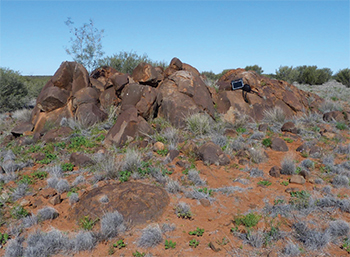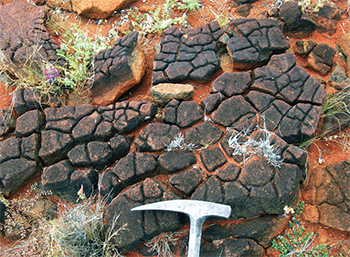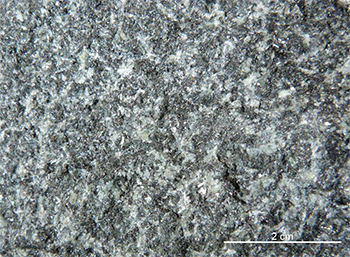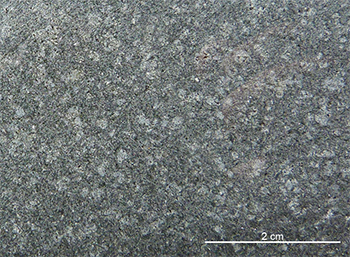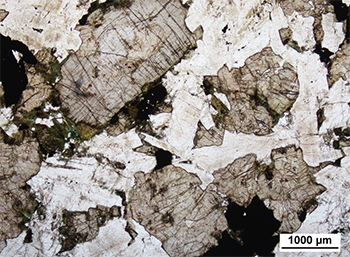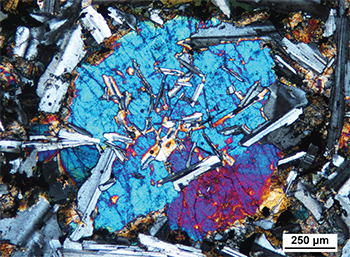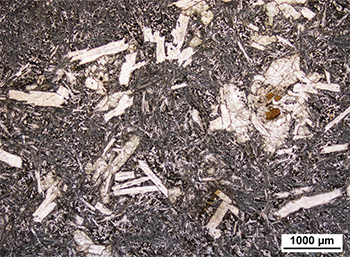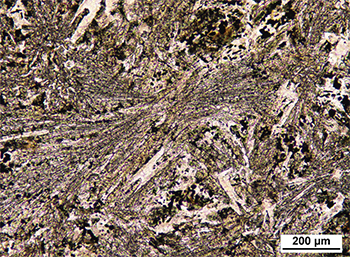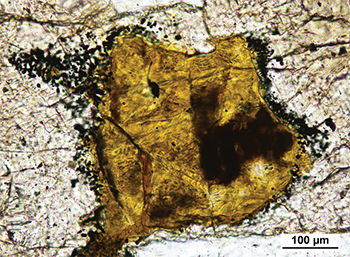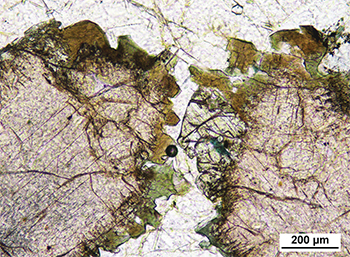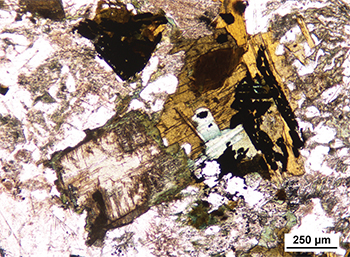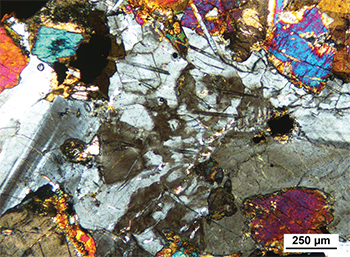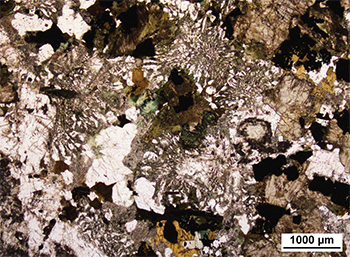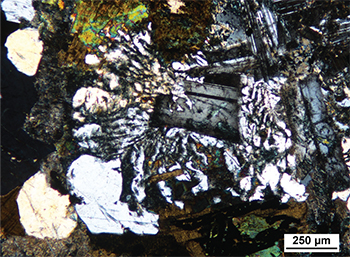Mario Werner, Rian Dutch, Mark Pawley and Carmen Krapf
Geological Survey of South Australia, Department for Energy and Mining
Download this article as a PDF (13.1 MB); cite as MESA Journal 87, pages 34–45
Published August 2018
Introduction
The Amata Dolerite is a mafic dyke suite that intruded the late Paleoproterozoic to Mesoproterozoic basement rocks of the Musgrave Province during the early Neoproterozoic at c. 800 Ma. Dykes of the Amata Dolerite occur within the Musgrave Province together with dykes of the older c. 1080 Ma Alcurra Dolerite and differentiating between these two mafic dyke suites poses a major challenge to geological mapping and mineral exploration in this area. The Amata Dolerite is enriched in economically important metals such as copper and gold, and thus potentially forms a significant source rock for sediment-hosted or fault-controlled hydrothermal mineral deposits. The Alcurra Dolerite is associated with coeval Giles Complex mafic–ultramafic intrusions that are prospective for orthomagmatic Ni–Cu – platinum group elements (PGE) mineralisation (Howard et al. 2009) and forms part of the Warakurna Large Igneous Province (Wingate, Pirajno and Morris 2004). This article describes the key characteristics of the Amata Dolerite within the eastern Musgrave Province of South Australia based on mapping within the ALCURRA 100,000 map sheet area (Krapf et al. 2017, 2018) and provides criteria to distinguish these two mafic igneous suites.
Recognising the differences between the Amata and Alcurra dolerites has geological significance. The Amata Dolerite is considered an equivalent of the Gairdner Dolerite (Goode 1970; Maboko 1988; Glikson et al. 1996; Sheraton and Sun 1997; Wingate et al. 1998; Edgoose, Scrimgeour and Close 2004; Howard et al. 2011), and along with the Willouran Basic Province (Hilyard 1990; Crawford and Hilyard 1990) and other coeval mafic igneous rocks, forms the Gairdner Large Igneous Province (Zhao, McCulloch and Korsch 1994; Foden et al. 2002; Claoué-Long and Hoatson 2009). The Gairdner Large Igneous Province extends from the Adelaide Geosyncline and Curnamona Province northwestwards to the Paterson Orogen in northwest Western Australia.
Wang et al. (2010) extended this province to the Willouran–Guibei Large Igneous Province in order to include coeval mafic rocks of the South China Block, which, according to the ‘Missing Link’ model of Li, Zhang and Powell (1995), was connected to southeastern Australia in the early Neoproterozoic as part of the Rodinia supercontinent. Magma formation and emplacement of coeval early Neoproterozoic mafic igneous rocks have been related to a major phase of mantle plume activity, which caused widespread decompression melting of asthenospheric mantle and the establishment of this large igneous province. Magmatism was accompanied by intracontinental rifting that ultimately led to the breakup of Rodinia at c. 720 Ma (Crawford and Hilyard 1990; Zhao and McCulloch 1993b; Zhao, McCulloch and Korsch 1994; Wingate et al. 1998; Li et al. 2006; Ernst et al. 2008; Li et al. 2008; Wang et al. 2009; Wang et al. 2010).
Consequently, understanding the timing, distribution, and processes associated with the Amata Dolerite in the eastern Musgrave Province is important for understanding global-scale geological processes and plate reconstructions. The distribution, lithology, geochemical characteristics and age constraints of the Amata Dolerite, as well as its broader significance, are discussed.
Distribution
Figure 1 Outcrop distribution and geochemistry sample locations of dykes of the Amata and Alcurra dolerites shown over TMI image.
The distribution of the Amata Dolerite in the eastern Musgrave Province is deduced from outcrop mapping and from interpretation of orthophoto, satellite and total magnetic intensity (TMI) images (Fig. 1). Dykes of the Amata Dolerite commonly form prominent linear magnetic anomalies due to their magnetite content and high magnetic susceptibility (Dutch, Pawley and Harvey 2014). The Amata Dolerite dykes can be traced along strike for up to 10 km in length and their thickness ranges from <1 m up to ~100 m. Larger dykes locally split up into several smaller dyke segments and en echelon offsetting of dyke segments is relatively common.
The Amata Dolerite occurs mainly in the southern half of the study area as several ESE- to SE-trending dyke swarms. The main outcrops are located in the southwestern part of the ALCURRA map sheet area (Fig. 1). An ~5 km wide, SE-trending dyke swarm occurs south of Mundy Dam. About 5 km farther north is an overall ESE-trending, wedge-shaped area of dyke intrusions with individual dykes clearly visible in TMI images as linear positive magnetic features (Fig. 1). This dyke swarm is ~8 km wide in the area west of Kangaroo Well and Guy Fawkes Bore but narrows to ~2 km around Agnes Creek Homestead and continues eastwards as a magnetic lineament to the Marryat Railway Station area, where the Amata Dolerite is sporadically exposed.
Figure 2 Rose diagram showing the trends of Amata Dolerite dykes within the study area in comparison with the strike directions of dispersed dykes of the Alcurra Dolerite occurring south of Gosse’s Lineament, i.e. south of the Alcurra Dyke Swarm.
An ~2 km wide zone of prominent ESE-trending high-magnetic intensity lineaments between Guy Fawkes Bore and the Marryat Fault probably represents an unexposed dyke swarm of the Amata Dolerite, which can be traced from the One Tree Bore area in the east to the confluence of the Alcurra and Marryat creeks in the west (Fig. 1). Another prominent positive magnetic lineament, which is also interpreted as an unexposed Amata Dolerite dyke, occurs directly to the north and parallel to the Marryat Fault.
Farther north, a prominent ESE-trending positive magnetic lineament is traceable between Sundown Outstation and Wallaby Rock. It represents another Amata Dolerite dyke or dyke set, which crops out at Wallaby Rock crosscutting the small Wallaby Rock pluton of the Pitjantjatjara Supersuite. North of Gosse’s Lineament, within the outcrop area of the Alcurra Dyke Swarm, dykes of the Amata Dolerite are virtually absent. An exception forms a narrow set of east- to ESE-trending dolerite dykes, exposed to the southwest of Holy Water Well, that belong to the Amata Dolerite as indicated by geochemistry.
Overall, the Amata Dolerite intruded older basement rocks in the study area as SE- to ESE-trending dyke swarms or dyke complexes. This contrasts with the strike directions of dispersed dykes of the Alcurra Dolerite south of the Alcurra Dyke Swarm (Figs 1, 2).
Lithological and mineralogical characteristics
Exposures of Amata Dolerite dykes in the study area range from scattered low rubbly to more prominent larger bouldery outcrops (Fig. 3a). Dolerite boulders often show onion-shell weathering and some outcrops are characterised by bread crust like weathering forms (Fig. 3b). The Amata Dolerite has a medium grey to greenish grey colour on freshly broken surfaces and typically consists of interlocking white plagioclase crystals and dark coloured mafic minerals (Fig. 3c). The dolerite is typically massive and samples with ophitic or subophitic texture display a conspicuous spotty pattern on polished surfaces (Fig. 3d). Thicker dykes commonly have fine-grained chilled margins and a coarse-grained gabbroic interior. Dolerite as well as adjacent basement rock is locally strongly epidotised along dyke margins giving the rock a greenish colour. Intensively weathered dolerite is exposed in some places as a light brown to white clayey saprolite, as dark brown ferruginised rock, or as greyish calcite-altered rock.
Figure 3 Outcrop and sample photos of the Amata Dolerite.
Figure 3a Bouldery dolerite outcrop SE of Mundy Dam forming part of a prominent SE-trending dyke. (SA Geodata site number 1970662; photo 416686)
Figure 3c Fresh dolerite sampled from a dyke ESE of Marryat Railway Station. (SA Geodata rock sample 2014838; photo 416688)
Thin sections show that the Amata Dolerite is mainly composed of plagioclase and clinopyroxene. Igneous textures range from intergranular in the core of wider gabbroic dykes, to (sub-)ophitic and porphyritic at the chilled dyke margins (Fig. 4a–c). Plagioclase (~40–60%) typically forms randomly oriented laths and prisms up to 2 mm and the typical pale fawn-brown colour is probably due to minute hematite inclusions. Plagioclase is also variably altered to sericite, zoisite and albite. Clinopyroxene (~30–55%) occurs as colourless to pale pinkish (Ti-augite) subhedral blocky crystals and crystal aggregates up to 1.5 mm in size and shows alteration to hornblende and actinolite. Clinopyroxene also occurs as subradiating sheaves of groundmass quench crystals (0.4–1.0 mm long) intergrown with acicular plagioclase microlites in a chilled dyke margin sample (Fig. 4d).
Figure 4 Photomicrographs showing igneous textures of the Amata Dolerite.
Figure 4a Intergranular texture of coarse-grained dyke interior with interlocking clinopyroxene and plagioclase crystals. (Sample 2014852; plane-polarised light; photo 416690)
Figure 4c Porphyritic texture of chilled dyke margin with plagioclase and clinopyroxene phenocrysts in fine-grained groundmass. (Sample 2014963, plane-polarised light; photo 416692)
Olivine occurs in some samples in small amounts (<1%) as inclusions in clinopyroxene but is usually completely altered to a yellowish brown phyllosilicate–goethite assemblage (Fig. 5a). Opaques (1–5%, mainly Fe–Ti oxides) form blocky crystals up to 2 mm in size with some magnetite showing skeletal crystal forms. Primary Fe–Ti oxides show alteration to secondary Fe-oxides and sphene. Pleochroic bluish green to yellowish brown hornblende (commonly <1–5%) marginally replaces and overgrows earlier formed clinopyroxene (Fig. 5b) and is commonly intergrown with late crystallising interstitial quartz, K-feldspar and apatite. Hornblende also occurs in some Amata Dolerite samples in significant amounts (~10%) as dark green grains occupying interstices between plagioclase and clinopyroxene. Biotite typically forms pleochroic dark brown to straw yellow to green flakes commonly in association with Fe–Ti-oxides (Fig. 5c) or as small inclusions within late interstitial quartz–feldspar. Quartz, K-feldspar and apatite fill late-formed interstices. Quartz and K-feldspar form small angular grains and minor micrographic intergrowths within these interstices (Fig. 5d) or are sparsely scattered through the rock. Apatite occurs as tiny prisms and acicular crystals as inclusions in quartz, feldspar, or amphibole (Fig. 5d).
The Amata Dolerite can be distinguished mineralogically from the Alcurra Dolerite, with the latter typically having a much higher olivine content of ~5–20%. However, this difference is commonly only visible in thin sections but not in hand specimens. The fact that some samples of the Amata Dolerite contain small amounts of both primary olivine (as phyllosilicate-altered pseudomorphs) and late interstitial quartz suggests that the basaltic magma was slightly silica undersaturated to allow early crystallisation of olivine, with the latest residual melt fractionating towards a silica- and iron-rich composition typical of the tholeiitic magmatic association.
Figure 5 Photomicrographs of minor mineral phases of the Amata Dolerite.
Figure 5a Phyllosilicate-altered olivine crystal surrounded by seam of tiny magnetite grains forming inclusion within clinopyroxene. (Sample 2014867, plane-polarised light; photo 416694)
Figure 5c Yellowish brown biotite grown on magnetite (right) next to clinopyroxene marginally replaced by hornblende (left). (Sample 2014838, plane-polarised light; photo 416696)
Basement contacts and contamination
Dykes of the Amata Dolerite intrude gneisses of the c. 1.7–1.5 Ga Birksgate Complex and c. 1.15 Ga granites of the Pitjantjatjara Supersuite. Locally they also crosscut dykes of the c. 1080 Ma Alcurra Dolerite, although contacts are rarely exposed. Larger dykes of the Amata Dolerite locally split up into several smaller dyke segments enclosing rafts of basement host rocks. About 5.5 km northwest of Agnes Creek Homestead, an ~80 m wide Amata Dolerite dyke encloses an ~20 m wide felsic gneiss sliver, which is crosscut by a number of 5–10 cm wide dykelets that splay off the main dyke. Macroscopically visible contamination of the Amata Dolerite with smaller basement xenoliths is relatively uncommon. This contrasts with the Alcurra Dolerite, which frequently displays evidence for contamination by the host rocks.
Despite the lack of macroscopic evidence for contamination in the Amata Dolerite, clear signs of basement contamination and assimilation can be seen in thin sections and in the geochemistry of some samples. In thin sections, such samples show abundant large patches (up to 1 mm in diameter) of radiating micrographic quartz–feldspar intergrowths (Fig. 6a). Some of these nucleate on plagioclase crystals or fill interstices between plagioclase crystals (Fig. 6b). These micrographic quartz–feldspar intergrowths probably originated from melting of small felsic gneiss or granite fragments entrapped by the intruding dolerite. Geochemically the basement contamination is reflected in elevated SiO2, K2O, Rb, Cs, Ba and Th concentrations, as well as in high La/Nb ratios and increased light rare earth elements (REE) fractionation.
Figure 6 Photomicrographs of Amata Dolerite affected by basement contamination.
Figure 6a Patches of radiating micrographic quartz–K-feldspar intergrowths within plagioclase–clinopyroxene–magnetite–hornblende–biotite dolerite. (Sample 2014838, plane-polarised light; photo 416698)
Geochemistry – a powerful tool to distinguish between the Amata and Alcurra dolerites
It is usually very difficult to macroscopically distinguish the Amata Dolerite from the Alcurra Dolerite. Thin sections can help to identify the Alcurra Dolerite as it is typically more olivine-rich. However, geochemistry is the best tool to distinguish these two dolerite suites (Table 1). The Amata Dolerite is a high-Fe–Ti and low-Mg tholeiitic mafic rock with Mg number mainly below 55, which contrasts markedly with the low-Fe–Ti and high-Mg Alcurra Dolerite with Mg number mainly above 55 (Fig. 7). Due to the olivine-poor nature of the Amata Dolerite, it has generally low concentrations of the compatible trace elements Ni, Co and Cr, whereas the olivine-rich Alcurra Dolerite is enriched in these elements. The Amata Dolerite shows elevated concentrations for some trace elements including Cu and Au (Fig. 7). These enrichments make the Amata Dolerite an important source rock for potential mineralisation, e.g. in fault zones where hydrothermal fluids can mobilise these elements and subsequently precipitate them to form Cu–Au deposits.
Table 1 Main distinguishing features of the Amata and Alcurra dolerites of the eastern Musgrave Province
| Amata Dolerite | Alcurra Dolerite | |
| Mineralogy | No or trace olivine | Olivine >5% |
| MgO (Mg#) range | 4–8 wt% (30–55) | 7–20 wt% (55–80) |
| Fe, Ti, P, Cu, V, Zn, Au, HFSE | Higher | Lower |
| Ni, Cr, Co | Lower | Higher |
| La/Nb ratio | <2 (mean trend of 1.25) | >2 (mean trend of 4) |
| La/Sm (LREE fractionation) | Mainly low | Mainly low (higher if contaminated) |
| Gd/Yb (HREE fractionation) | Higher | Lower |
| Sm–Nd isochron age | 766 ± 53 Ma | 1110 ± 56 Ma |
| ɛNd(t) | +1.7 to +3.3 (t = 800 Ma) | -4.1 to -0.8 (t = 1080 Ma) |
| Dyke orientation | Mainly ESE to SE | ENE to ESE, minor NNE |
| Dyke width |
Mainly 50–100 m, minor <1–30 m | Mainly <10 m, rarely up to 80 m |
Figure 7 Binary variation diagrams of Fe2O3T, MgO, Cu and Au vs Mg number, chondrite-normalised REE patterns and Nb vs La plot for the Amata and Alcurra dolerites.
The Amata Dolerite is characterised by high contents of high field strength elements (HFSE) such as Zr, Nb and REE, which are depleted in the Alcurra Dolerite. Chondrite-normalised REE plots clearly show the high REE abundance of the Amata Dolerite in comparison to the Alcurra Dolerite (Fig. 7). Subtle differences in the overall shape of REE patterns can also be used to discriminate these two dolerite suites. Light REE fractionation as indicated by (La/Sm)N ranges mainly between 1 and 2 for both suites. However, the heavy REE are slightly more fractionated in the Amata Dolerite ((Gd/Yb)N 1.5–2) than in the Alcurra Dolerite ((Gd/Yb)N mainly 1–1.5). La/Nb ratios are the most powerful distinguishing features between the younger Amata Dolerite and the older Alcurra Dolerite in the eastern Musgrave Province. The Amata Dolerite mainly follows a La/Nb ratio trend of about 1.25 with some basement-contaminated samples deviating from this trend and approaching a La/Nb ratio of 2 (Fig. 7). The Alcurra Dolerite has generally La/Nb ratios larger than 2 and overall follows a La/Nb ratio trend of about 4 (Werner et al. 2014, 2015).
Contrasting geochemical characteristics of the Amata and Alcurra dolerites mainly originate from melting of different mantle source regions. The Amata Dolerite has smooth positively sloped REE patterns and trace element characteristics that are similar to those of continental flood basalts. These features and juvenile isotopic signatures indicate that the Amata Dolerite is largely derived from decompression melting of upwelling depleted asthenospheric mantle or a rising mantle plume (Zhao and McCulloch 1993b; Zhao, McCulloch and Korsch 1994; Foden et al. 2002). In contrast, pronounced HFSE depletions (especially Nb), selective large ion lithophile element enrichments (K, Sr, Ba), and evolved isotopic signatures for the Alcurra Dolerite appears to reflect partial melting of a metasomatised, subduction-modified subcontinental lithospheric mantle (Zhao and McCulloch 1993a, b; Glikson et al. 1996; Sheraton and Sun 1997). Furthermore, our studies in the eastern Musgrave Province have shown that emplacement of the Amata Dolerite was accompanied by only minor crustal contamination, whereas this was a significant process for the Alcurra Dolerite.
Age – implications from the record of early Neoproterozoic mantle plume magmatism within Rodinia
Attempts to extract zircon or baddeleyite from samples of the Amata Dolerite collected in the eastern Musgrave Province were unsuccessful and thus no precise age dates are available from its type area. Imprecise Sm–Nd isochron ages of 790 ± 40 and 797 ± 49 Ma were reported for NW-trending dolerite dykes near the town of Amata (Zhao and McCulloch 1993b; Zhao, McCulloch and Korsch 1994). A dyke sample with Amata Dolerite like geochemistry, collected within the TIEYON map sheet area at the eastern outcrop margin of the Musgrave Province, yielded an imprecise age of c. 760 Ma, with the Sm–Nd age of 766 ± 53 Ma in good agreement with its Rb–Sr age of 758 ± 21 Ma (Dutch et al. 2013; Werner et al. 2014). A similar age uncertainty is also reported for the west Musgrave Province, where a sample from an unnamed mafic dyke suite yielded a Sm–Nd isochron age of 747 ± 48 Ma. Howard et al. (2011) suggested that these c. 750 Ma mafic rocks are either part of the c. 825 Ma Gairdner magmatic event, or represent a slightly younger suite, possibly contemporaneous with the c. 755 Ma Mundine Well Dolerite Suite of northwestern Australia (Wingate and Giddings 2000; Li et al. 2006).
Based on the correlation of the Amata Dolerite with the Gairdner Dolerite (see introduction), the age of the Gairdner Dolerite should also apply to the Amata Dolerite. The Gairdner Dolerite is constrained by SHRIMP U–Pb age of 827 ± 6 Ma from baddeleyite and zircon extracted from a dolerite dyke sample from drillhole RL 1 (Reedy Lagoon, northwestern Stuart Shelf, SA Geodata drillhole number 16695; Wingate et al. 1998). This early Neoproterozoic age was confirmed by LA-ICPMS U–Pb dating of magmatic apatite as well as hydrothermal apatite and titanite from Gairdner Dolerite dykes at Olympic Dam, which yielded ages of c. 825–820 Ma (Huang et al. 2015, Apukhtina et al. 2016). A similar age was also reported for the Little Broken Hill Gabbro in the Curnamona Province (Pb–Pb zircon 827 ± 9 Ma; Wingate et al. 1998). Furthermore, a sample of the Gairdner Dolerite equivalent type B mafic dykes of the Tomkinson Ranges in the western Musgrave Province yielded a U–Pb baddeleyite age of 824 ± 4 Ma (S s Sun, unpublished data in Glikson et al. 1996).
The apparently slightly younger Neoproterozoic ages of mafic rocks from the eastern Musgrave Province, derived from Sm–Nd dating, raise an important question. Were these rocks, including samples of the Amata Dolerite, indeed part of the Gairdner Dolerite magmatism, or do they represent a distinct episode of mafic magmatism? Post-825 Ma early Neoproterozoic magmatism in South Australia is sporadically documented for the Adelaide Geosyncline, including the Rook Tuff (802 ± 10 Ma; Fanning et al., 1986), the Oodla Wirra Volcanics (798 ± 5 and 799 ± 4 Ma; Fabris et al., 2005), the Burra porphyry (794 ± 4 Ma) and volcaniclastics within the Skillogalee Dolomite (788 ± 7 Ma; Preiss, Drexel and Reid 2009).
Figure 8 Schematic paleogeographic map showing the distribution of early Neoproterozoic (825–750 Ma) igneous rocks within parts of the Rodinia supercontinent (compiled from Li, Zhang and Powell 1995; Harlan et al. 2003; Li et al. 2006; Li et al. 2008; Wang et al. 2010).
It is possible to examine this issue by looking at South China, which has one of the best-preserved and best-documented records of early Neoproterozoic, c. 825–760 Ma giant plume-driven mafic magmatism in the world (Li et al. 2008; Wang et al. 2009). This is highly relevant to the early Neoproterozoic magmatic record of the Musgrave Province and the Gawler Craton because in some reconstructions of the Rodinia supercontinent, southeastern Australia was potentially connected to the South China Block at that time (Li, Zhang and Powell 1995) (Fig. 8). The period 825–800 Ma represents the first major phase of basaltic magmatism in South China (Li et al. 2003; Li et al. 2008; Wang et al. 2009, 2010), which occurred before and during early intracontinental rifting and is comparable to the early Neoproterozoic magmatism and rifting recorded for the Adelaide Geosyncline and surrounding crustal provinces. A subsequent second phase of major mafic magmatism associated with major rifting is well documented in South China for the period 790–750 Ma (Li et al. 2003; Lin, Li and Li 2007; Zhou et al. 2007; Li et al. 2008; Wang et al. 2009). A potential equivalent of this slightly younger Neoproterozoic magmatic phase is the c. 780 Ma Gunbarrel mafic magmatic event (Harlan et al. 2003) (Fig. 8). It is recorded along the western margin of Neoproterozoic Laurentia, which was connected to the South China Block on the opposite side of the contact to Australia (Li, Zhang and Powell 1995; Li et al. 2008). The early Neoproterozoic plume-related magmatism and rifting ultimately led to the breakup of the Rodinia. By c. 720 Ma, the South Australian Craton and the South China Block were probably separated from each other by a wide ocean (Li, Zhang and Powell 1995).
Consequently, age constraints for the Amata Dolerite demonstrate that it forms part of the Gairdner–Willouran–Guibei Large Igneous Province, which formed in the early Neoproterozoic due to giant mantle plume activity. These regions were subsequently dismembered and dispersed during the breakup of the supercontinent Rodinia (Wang et al. 2010). The older c. 825 Ma Gairdner Dolerite and age-equivalent mafic rocks correspond to the first magmatic cycle (c. 825–800 Ma) in the South China Block. In the light of the well-documented early Neoproterozoic history of mafic magmatism in South China, it appears plausible that some of the mafic dykes in the Musgrave Province, including parts of the Amata Dolerite, record the second, younger cycle of magmatism (c. 790–750 Ma), as tentatively indicated by the above mentioned Sm–Nd ages. This is further supported by the fact that this younger phase of early Neoproterozoic magmatism is well documented in mafic rocks located paleogeographically both to the west (northwestern Australia) and to the east (South China and western Laurentia) of the Amata Dolerite region within Rodinia (Fig. 8).
Precise U–Pb zircon or baddeleyite dating of the Amata Dolerite and other potentially coeval mafic intrusions in the Musgrave Province and surrounding crustal provinces would be necessary to verify that distinct phases of early Neoproterozoic mafic magmatism existed over an extended period of time also in central-southeastern Australia.
Summary
The Amata Dolerite intruded Paleo- to Mesoproterozoic basement units of the Musgrave Province. These include dykes of the Alcurra Dolerite, which form part of the Warakurna Large Igneous Province. Differentiating between these two similar, but unrelated, mafic dyke suites can be challenging but is important for geological mapping and mineral exploration. Major differences are geophysical properties as well as mineralogical and geochemical characteristics. Magnetic susceptibility of the Amata Dolerite is high due to its magnetite-richness and results in excellent visibility of its dykes in TMI images as linear positive magnetic anomalies. Geochemistry is the best tool to distinguish these two mafic suites. The Amata Dolerite is low in Mg but high in Fe, Ti, V, Zn and HFSE. This contrasts with the high-Mg–Cr–Ni and low-Fe–Ti nature of the Alcurra Dolerite, which is further characterised by strong HFSE depletions. Low La/Nb ratios (<2) are indicative of the Amata Dolerite, whereas the Alcurra Dolerite typically has high La/Nb ratios (>2). Enrichments in Cu and Au make the Amata Dolerite an important source rock for potential sediment-hosted or fault-controlled hydrothermal mineral deposits, whereas the Alcurra Dolerite is prospective for magmatic Ni–Cu–PGE deposits.
Age constraints for the Amata Dolerite show that it forms part of the Gairdner–Willouran–Guibei Large Igneous Province that formed in the early Neoproterozoic due to giant mantle plume activity. The Amata Dolerite is usually correlated with the c. 825 Ma Gairdner Dolerite. However, apparently slightly younger Sm–Nd ages for some Amata Dolerite dykes and other unnamed mafic dykes of the Musgrave Province tentatively indicate that mafic magmatism in southeastern Australia may have happened over an extended period within the early Neoproterozoic. This is comparable with the situation in the South China Block, where two distinct phases of early Neoproterozoic mafic magmatism, at 825–800 and 790–750 Ma, are well documented. South China was probably connected with Australia in the early Neoproterozoic forming parts of a large igneous province within the Rodinia supercontinent. Both regions experienced early Neoproterozoic mantle plume magmatism associated with rifting that ultimately led to the breakup of Rodinia and the dismemberment of this igneous province.
References
Apukhtina OB, Kamenetsky VS, Ehrig K, Kamenetsky MB, McPhie J, Maas R, Meffre S, Goemann K, Rodemann T, Cook NJ and Ciobanu CL 2016. Postmagmatic magnetite-apatite assemblage in mafic intrusions: a case study of dolerite at Olympic Dam, South Australia. Contributions to Mineralogy and Petrology 171(1), article 2.
Claoué-Long JC and Hoatson DM 2009. Guide to using the Map of Australian Proterozoic Large Igneous Provinces, Record 2009/44. Geoscience Australia, Canberra.
Crawford AJ and Hilyard D 1990. Geochemistry of late Proterozoic tholeiitic flood basalts, Adelaide Geosyncline, South Australia. In JB Jago and PS Moore eds, The evolution of a late Precambrian - early Palaeozoic rift complex: the Adelaide Geosyncline, Special Publication 16. Geological Society of Australia, pp. 49–67.
Edgoose CJ, Scrimgeour IR and Close DF 2004. Geology of the Musgrave Block, Northern Territory, Report 15. Northern Territory Geological Survey, Darwin.
Ernst RE, Wingate MTD, Buchan KL and Li ZX 2008. Global record of 1600–700 Ma large igneous provinces (LIPs): implications for the reconstruction of the proposed Nuna (Columbia) and Rodinia supercontinents. Precambrian Research 160(1–2):159–178.
Fanning CM, Ludwig KR, Forbes BG and Preiss WV 1986. Single and multiple grain U–Pb zircon analyses for the early Adelaidean Rook Tuff, Willouran Ranges, South Australia. Proceedings of the 8th Australian Geological Convention, Abstracts 15. Geological Society of Australia, Sydney, pp. 71–72.
Foden J, Song SH, Tuner S, Elburg M, Smith PB, Steldt BV and Penglis BV 2002. Geochemical evolution of lithospheric mantle beneath S.E. South Australia. Chemical Geology 182(2–4):663–695.
Glikson AY, Stewart AJ, Ballhaus CG, Clarke GL, Feeken EHJ, Leven JH, Sheraton JW and Sun S-s 1996. Geology of the western Musgrave Block, central Australia, with particular reference to the mafic-ultramafic Giles Complex, Bulletin 239. Australian Geological Survey Organisation, Canberra.
Goode ADT 1970. The petrology and structure of the Kalka and Ewarara layered basic intrusions, Giles Complex, central Australia. PhD thesis, University of Adelaide.
Harlan SS, Heaman L, LeCheminant AN and Premo WR 2003. Gunbarrel mafic magmatic event: a key 780 Ma time marker for Rodinia plate reconstructions. Geology 31(12):1053–1056.
Hilyard D 1990. Willouran Basic Province: stratigraphy of late Proterozoic flood basalts, Adelaide Geosyncline, South Australia. In JB Jago and PS Moore eds, The evolution of a late Precambrian - early Palaeozoic rift complex: the Adelaide Geosyncline, Special Publication 16. Geological Society of Australia, pp. 34–48.
Howard HM, Smithies RH, Evins PM, Kirkland CL, Werner M, Wingate MTD and Pirajno F 2011. Explanatory notes for the west Musgrave Province, Record 2011/4. Geological Survey of Western Australia, Perth.
Howard HM, Smithies RH, Kirkland CL, Evins PM and Wingate MTD 2009. Age and geochemistry of the Alcurra suite in the west Musgrave Province and implications for orthomagmatic Ni-Cu-PGE mineralization during the Giles Event, Record 2009/16. Geological Survey of Western Australia, Perth.
Huang Q, Kamenetsky VS, McPhie J, Ehrig K, Meffre S, Maas R, Thompson J, Kamenetsky M, Chambefort I, Apukhtina O and Hu Y 2015. Neoproterozoic (ca. 820-830 Ma) mafic dykes at Olympic Dam, South Australia: links with the Gairdner Large Igneous Province. Precambrian Research 271:160–172.
Li XH, Li ZX, Wingate MTD, Chung SLC, Liu Y, Lin GC and Li WX 2006. Geochemistry of the 755 Ma Mundine Well dyke swarm, northwestern Australia: part of a Neoproterozoic mantle superplume beneath Rodinia? Precambrian Research 146(1–2):1–15.
Li ZX, Bogdanova SV, Collins AS, Davidson A, De Waele B, Ernst RE, Fitzsimons ICW, Fuck RA, Gladkochub DP, Jacobs J, Karlstrom KE, Lu S, Natapov LM, Pease V, Pisarevsky SA, Thrane K and Vernikovsky V 2008. Assembly, configuration, and break-up history of Rodinia: a synthesis. Precambrian Research 160(1–2):179–210.
Li ZX, Li XH, Kinny PD, Wang J, Zhang S and Zhou H 2003. Geochronology of Neoproterozoic syn-rift magmatism in the Yangtze Craton, south China and correlations with other continents: evidence for a mantle superplume that broke up Rodinia. Precambrian Research 122(1–4):85–109.
Li ZX, Zhang L and Powell CMcA 1995. South China in Rodinia: part of the missing link between Australia-East Antarctica and Laurentia? Geology 23(5):407–410.
Lin GC, Li XH and Li WX 2007. SHRIMP U-Pb zircon age, geochemistry and Nd-Hf isotope of Neoproterozoic mafic dyke swarms in western Sichuan: petrogenesis and tectonic significance. Science China Earth Sciences 50(1):1–16.
Maboko MAH 1988. Metamorphic and geochronological evolution in the Musgrave Ranges, central Australia. PhD thesis, Australian National University, Canberra.
Sheraton JW and Sun S-s 1997. Mafic dyke swarms of the western Musgrave Block, central Australia: their geochemistry, origin, and relationships to the Giles Complex. AGSO Journal of Australian Geology & Geophysics 16(5):621–636.
Wang XC, Li XH, Li WX and Li ZX 2009. Variable involvements of mantle plumes in the genesis of mid-Neoproterozoic basaltic rocks in south China: a review. Gondwana Research 15(3–4):381–395.
Wang XC, Li XH, Li ZX, Liu Y and Yang YH 2010. The Willouran Basic Province of South Australia: its relation to the Guibei Large Igneous Province in south China and the breakup of Rodinia. Lithos 119(3–4):569–584.
Wingate MTD, Campbell IH, Compston W and Gibson GM 1998. Ion microprobe U-Pb ages for Neoproterozoic basaltic magmatism in south-central Australia and implications for the breakup of Rodinia. Precambrian Research 87(3–4):135–159.
Wingate MTD and Giddings JW 2000. Age and palaeomagnetism of the Mundine Well Dolerite, Western Australia: implications for an Australia-Laurentia connection at 755 Ma. Precambrian Research 100(1):335–357.
Wingate MTD, Pirajno F and Morris PA 2004. Warakurna Large Igneous Province: a new Mesoproterozoic large igneous province in west-central Australia. Geology 32(2):105–108.
Zhao J-x and McCulloch MT 1993a. Melting of a subduction-modified continental lithospheric mantle: evidence from late Proterozoic mafic dike swarms in central Australia. Geology 21:463–466.
Zhao J-x and McCulloch MT 1993b. Sm-Nd mineral isochron ages of late Proterozoic dyke swarms in Australia: evidence for two distinct events of mafic magmatism and crustal extension. Chemical Geology 109:341–354.
Zhao J, McCulloch MT and Korsch RJ 1994. Characterisation of a plume-related ~ 800 Ma magmatic event and its implications for basin formation in central-southern Australia. Earth and Planetary Science Letters 121:349–367.
Zhou J, Li XH, Ge W and Li ZX 2007. Age and origin of middle Neoproterozoic mafic magmatism in southern Yangtze Block and relevance to the break-up of Rodinia. Gondwana Research 12(1–2):184–197.




